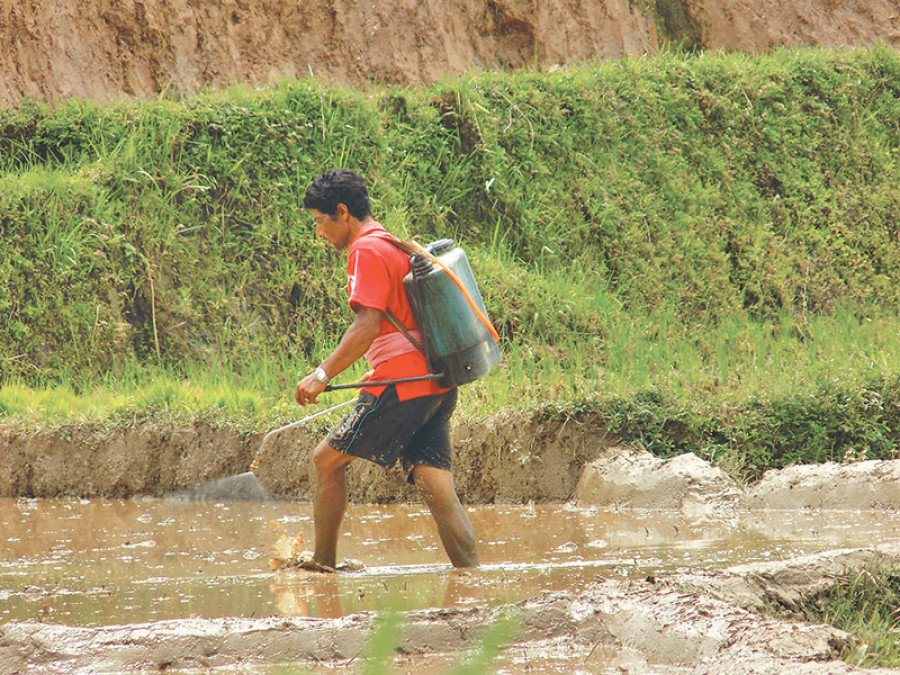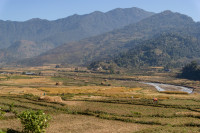Opinion
A useful poison?
Regulations for pesticide use, safety, and management have to be adopted to safeguard against potential health risks
Anil Shrestha
Historically, the majority of the agricultural systems in Nepal have been limited to subsistence farming. In recent years, commercial vegetable farming has been observed to be increasing in some peri-urban areas of Nepal. This trend seems to be demand-driven by urban consumers, by the adoption of farming as a livelihood by youth returning from nations abroad with capital and technical knowledge, and by the promotional programs of INGOs and NGOs. Furthermore, some of these programs seem to have empowered pesticide vendors who are not adequately trained on pesticide safety issues.
Controlling pests
Crop production is no easy venture, as crops are vulnerable to attack from many kinds of pests. To farm commercially and profitably, these attacks need to be controlled. Globally, an average of 40 percent of the potential yield is lost as a result of the damage caused by pests. So, in many countries, pesticides have been adopted by commercial farmers as they provide immediate, short-term, cost-effective management of pests, and reduce the risk of crop failure. However, many developed countries have strict regulations on pesticide use, safety, and promote integrated pest management (IPM) programs.
Most of the farmers who are involved in commercial farming in peri-urban areas of Nepal seem to have adopted pesticides as part of their farming practice. In Nepal, pesticides were introduced in 1955 and pesticide regulations were introduced in 1991, but it is not known how strictly and widespread the adoption of these regulations have been. Some articles indicate that pesticide use is rampant in Nepal and often misused, causing health risks to the applicators themselves as well as to their clientele.
Furthermore, reports also show that a substantial portion of these pesticides are used in vegetables that enter into the urban market. From a consumer standpoint, most of us also prefer pest-damage free, clean vegetables with no blemishes. Therefore, it is suspected that pesticide use will be an inevitable part of these commercial vegetable farming systems and their use will only continue to grow if alternatives to pesticides are not developed and our own view, as consumers, are not changed.
Growing awareness
Urban people are the major consumers of vegetables grown in these peri-urban areas and their awareness on the health risks of pesticides seems to be increasing. However, they are unaware of the residue levels in the vegetables they are consuming. It is possible that the produce are still relatively safe and within allowable maximum residue levels (MRLs) but the contrary could also be true as Nepal is yet to set up a reliable system of residue detection and the associated regulatory mechanisms. Till then, consumers will have to rely on unsubstantiated hearsay such as rumours that farmers in Dhading spray their cauliflower plants 13-15 times with pesticides before bringing them to the market to sell. Again, it is emphasised that these are anecdotes that need to be documented with proper research. It seems that several farmers are aware of integrated pest management but apply pesticides as it is a last resort to prevent their crops and their livelihoods from perishing. It is the responsibility of researchers to develop pesticide alternatives and provide proper pesticide education for these growers. Equally important is the need to have an effective pesticide monitoring and regulation system in place. It seems farmers in Nepal, to some extent, are aware of the dangers of pesticides but they do not have as much knowledge about safety issues as their counterparts in developed countries. If reliable and cost-effective alternatives are provided to them, it is likely that they would reduce the use of pesticides as they are expensive and farmers know about the dangers to a certain level.
Organic farming can be an alternative if reliable and cost-effective pest management systems are developed. In fact, one of the biggest challenge to widespread adoption of organic farming is the challenge from pests. Therefore, it is a misconception that pesticides are not used in organic farming. Usually organically-acceptable pesticides or natural pesticides are used in such systems. Often, such pesticides could also be dangerous if their toxicity to living beings is not evaluated properly or if they are used improperly. Therefore, these products should also be properly monitored and regulated. For example, chicken manure is often used as an organic fertiliser, but the manure may be from chickens that have been fed with feed containing harmful doses of hormones or chemicals. These harmful materials could also be transferred to the crop. Also, the cost of production can also be higher in an organic system because of pest problems so producers should be able to get premium prices for their products while consumers should be willing to pay these higher prices. Again, proper monitoring and regulation programs needs to be in place for the certification of these organic products.
The fear of pesticide contamination seems to have attracted urban-dwellers to roof-top organic gardening of vegetables in Nepal. However, it should be noted that these are fairly new types of agro ecosystems, and over time, pests will adapt to these systems and other environmental issues may later emerge. Therefore, researchers should start exploring the possibility of potential issues with such systems.
Alternative systems
Most of the vegetables being grown commercially in Nepal are for fresh-market purposes. Sole reliance on a fresh-market can be problematic in Nepal because of frequent road closures due to natural and man-made causes. Delay in the produce reaching the market can cause the produce to perish, thus, incurring heavy losses to the farmers. However, there is an opportunity in Nepal to develop alternative marketing systems for these vegetables such as pickling; selling as frozen products; and making purees, pastes, and sauces etc. Such products could also have an export market. However, international food and pesticide safety standards will have to be strictly followed and the MRL of each country will have to be respected.
In conclusion, instead of blaming farmers, there is a need to develop reliable, economic, and safe pest management systems with proper use regulations, and monitoring programs if commercial vegetable farming is to be promoted as a sustainable means of livelihood in peri-urban areas of Nepal. Practical and effective IPM programs should be developed instead of using and promoting the concept of IPM in theory. In other words, regulators, researchers, pesticide vendors, farmers, and consumers all need to work together for safe and effective use of pesticides rather than blaming each other. Till then, let’s stop blaming only farmers for this pesticide dilemma in Nepal.
- Shrestha is a Professor in the Department of Plant Science at California State University and is currently working as a visiting scientist at ICIMOD




 12.12°C Kathmandu
12.12°C Kathmandu










